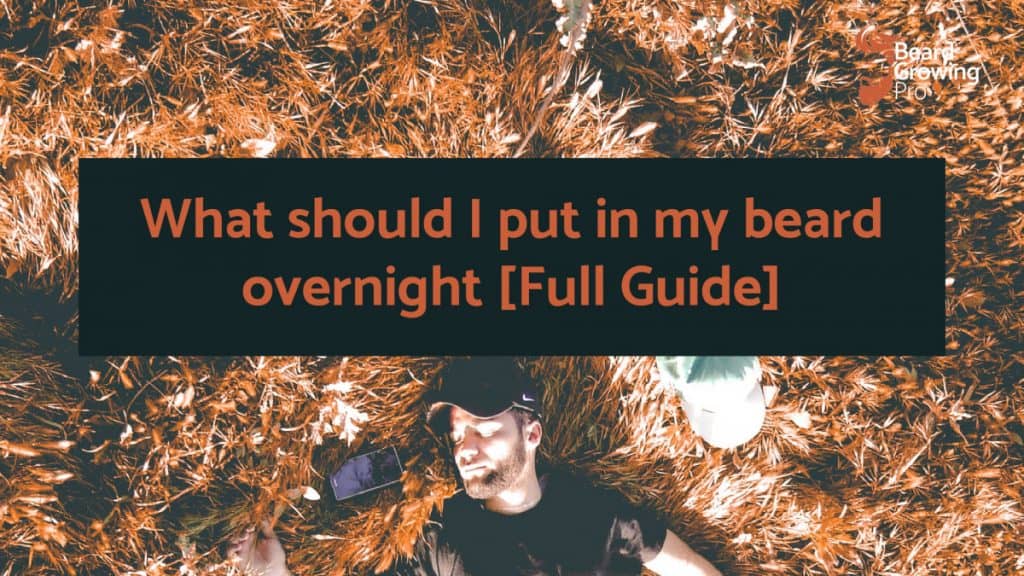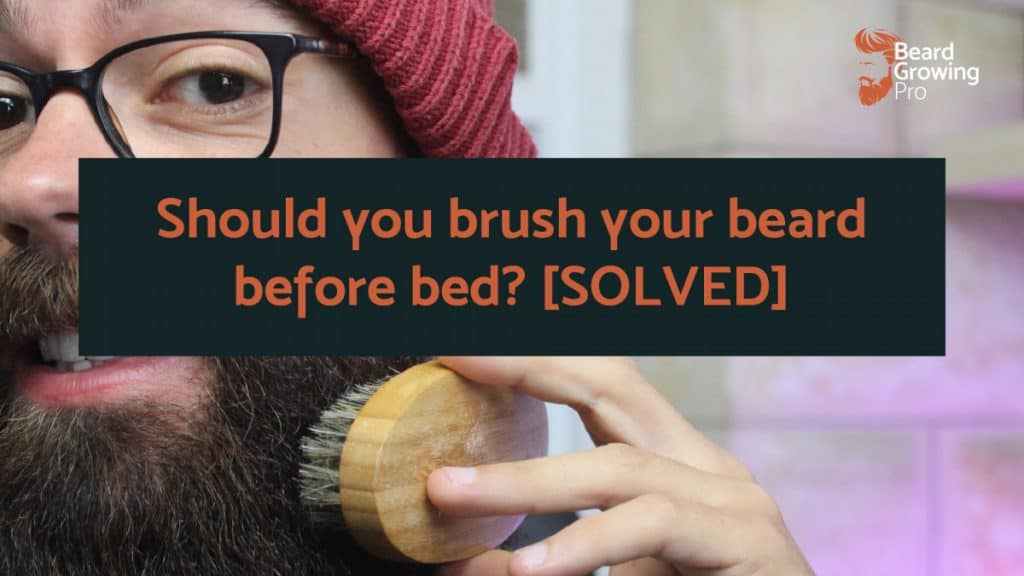Protecting your beard at night is a very important step in growing a healthy and thick beard. You spend a huge amount of your time sleeping, and meshing your beard into the pillow at night may be causing it more harm than you know. Once I took more time to look at my nighttime routine, I noticed a significant decrease in beard hairs that I shed throughout the day.
Wrapping your beard at night involves ensuring it is dry, brushing it with a soft bristle brush, applying products for a deeply nourishing treatment, wrapping your beard with a beard bonnet or low friction material, and choosing a pillow that allows you to sleep comfortably.
You should consider going through several steps if you want to wrap your beard at night. One of the easiest ways to wrap your beard is to purchase a beard bonnet. If you do not want to prepurchase a product such as a beard wrap or a beard bonnet, you can use a satin or silk material which you can use to cover your beard completely.
Here are all the steps you should go through to understand how to wrap your beard at night.
Article Contents
Steps for wrapping your beard before sleeping
The preparation for wrapping your beard is just as important as the act of actually wrapping your beard.
1. Ensure that it is dry
You should make sure that your beard is completely dry before you wrap your beard. Wet hair is very easy to damage. The water penetrates deep into the hair and weakens the bonds between the hair proteins.
If you are a person who showers before bed, you should make sure that you completely dry your beard using a hairdryer or other heat tool so that your hair is as strong as possible when it is resting between your head and your pillow.
Hair is comprised of protein created in the hair follicle. In the middle of the hair are proteins called keratin, and they are covered in cuticles which is like a protective covering for the middle of the hair. When hair is wet, it absorbs the water and swells. This interrupts the bonds in the hair, making it easier to damage.
As the hair is stretched (through movements of your face on your pillow), the stretching deforms the outer protective layer causing the cuticle edges to lift and break. Once its cuticle armour is damaged, it can make the beard feel rough and wirier.
It would help if you took extra care of your hair when it is wet.
You should try your beard hair as thoroughly as possible. Using a microfibre towel combined with a blow dryer on medium or high heat, you can do this. I check how dry my beard is at the root by using a cold setting on the hairdryer – this means that I can feel the evaporation of the water from the roots of the hair. If I feel any coldness, I keep going until the sensation of the water evaporating no longer exists.
I also like to let my hair air dry for a few minutes before putting any oil or butter into my hair.
Sleeping with a slightly damp beard can also increase the risk of fungal infection.
Beards can become a damp environment very easily due to their density and the depth of the hair coverage. If you put dry material on a wet beard, the material will not wake away from the water and moisture. It can cause a very nice humid environment next to your skin, perfect for fungal and bacterial growth.
2. Brush with a soft bristle brush
After you have made sure that your beard is dry, you should brush it thoroughly.
Brushing your beard with a soft bristle brush does several things, including:
- Removing dirt and grime – brushing your beard of an evening means that you are removing dirt and grime that has built up during the day. No sharp particles are left in your beard (from sand and small dust particles), which can significantly damage the cuticles of your beard hair if rubbed against them overnight.
- Remove dead hairs – Brushing out your beard before you go to bed means removing the hairs that no longer sit securely in the hair follicle. Also, it means that your partner will be less annoyed by all of the beard hairs which inevitably end up in the bed!
- Removed tangles – The longer the beard, the more important it becomes to detangle the hair before you go to bed.
- Redistribute sebum – One of the most important things that brushing does is redistribute the natural oils made on your skin’s surface. Sebum is the natural oil that is produced by glands on the surface of the skin. If you have not brushed your beard regularly, the oil can very easily stay at the roots of the hair and not make its way to the tips.
- Tackle static – You may also want to brush your beard to tackle any issues with static that builds up during the day. Dry and cold conditions can easily lead to dry hair that can build up static.
3. Apply products
Protecting your beard with products overnight is one of the best ways to ensure a strong and healthy beard. If you want to know what you can and cannot put in your beard overnight, check out my full guide in my other article.

Applying products that you put in just before bed allows extra time for absorption into the beard. If your beard is particularly dry and you have tried everything you can do hydrated, maybe deep hydration overnight may work.
If you want to apply products to your beard overnight, you can use beard butter, beard oil, beard conditioner, as long as they do not contain many water-based ingredients or jojoba oil.
For example, jojoba oil is not readily absorbed by the hair – the skin much more easily absorbs it. Argan oil is much more readily absorbed by Argan oil or sweet almond oil.
The only other issue that you need to be concerned about with beard oil is the essential oil. Essential oils need to be diluted, so they do not irritate the skin.
If your beard oil contains a lot of essential oils, it can irritate the skin since, at high concentrations, it can easily become an irritant.
4. Choose your favourite beard wrap
It would help if you allowed at least 15 to 20 minutes for most of the product to absorb effectively into your hair. After which, you can then use your favourite beard wrap or beard bonnet to detect your beard while you are sleeping.
Beard bonnet
Beard wraps are beard bandannas, beard durags, beard bonnets, beard guards, and beard rags. They are becoming increasingly popular to wear at night by bearded people all over the world. They are an excellent way to protect your beard while sleeping, and they are the only dedicated beard product on this list that could help you protect your beard as you sleep.
I have never considered using a beard wrap, but I am certainly much more interested after reading their benefits and knowing that my beard is a little longer.
I can sometimes get a little bit self-conscious, even in front of the people I love most. But, if you want to look at your beard at night or you are a particularly heavy sleeper, and you are active while you are sleeping, a beard wrap will put a physical barrier between your beard and your pillow.
The internal material is typically soft like satin or silk, which means that you can protect your beard without buying a separate silk pillow.
Satin material
If you do not want to wrap your beard in a beard bonnet or a beard durag you can apply a satin wrap to your beard using one of two techniques. Firstly, you can use a beard wrap that Sikhs use to cover their beard.
You can see an example of this in the YouTube video below.
The only bit that I would change if you were wrapping your beard overnight is not to apply any hold material such as hairspray or elastic bands. Staying away from these materials will allow your beard to breeze and absorb your product overnight.
Another way is shown in the video below.
Protecting your beard using a soft satin wrap and tying it up over the top of your head will mean that it stays in place much more comfortable than elastic over the ears.
If you are applying a cover to your beard from a single strip of material, it will not protect the moustache area, but the important parts of the beard are covered, such as the chin and the sites. These are the parts that most come into contact with your pillow throughout the night.
5. Completely cover beard
No matter what you use to hold your beard, whether it is a beard bonnet or a piece of material, you should make sure that it completely covers the sides of your beard.
If it does not completely cover the sides of your beard and your chin area, I recommend buying a bigger bit of material and poking in any stray hairs with a knitting needle.
Ensure that no hairs are trapped along the edges of the beard wrap. Any hairs that are trapped and twisted along the edges of the beard wrap may end up becoming broken. The hairs trapped along the edge will have all of the force of your head focused on them.
6. Choose the right height pillow
Lastly, choosing the most comfortable pillow height means that you are less likely to toss and turn throughout the night, and you are less likely to put the full force of your head on your pillow. I recommend using a relatively low pillow so that the weight of your head is not focused on your jaw and chin area.
In the morning
In the morning, your beard will be artificially flattened due to the full coverage of the material. If you have put on your beard wrap properly, it should not have moved out of place overnight, and it should not be so tight that it leaves indentations on your skin or beard.

Revitalising your beard in the morning is relatively simple if you follow these steps.
Wet the beard
I wash my beard every single morning. You can lightly wet the beard to disrupt the shape moulded into it overnight if you do not.
The water can disrupt the bonds of the hair and make it bushy. Sometimes even a light steaming in the shower seems to do the trick. It puffs up even the most stubborn of flat hairs.
Blow-dry into shape
Using your blow dryer or favourite heat tool, you should blowdry your beard into shape and brush it with a soft bristle until it suits your desired style.
Apply a product with hold
Once your beard has achieved your desired shape, you should apply a product with hold. Products with hold include anything that contains wax. I often apply my DIY beard oil, which contains about 50% beeswax, to hold the style for a little bit longer than it would hold naturally.
Products to avoid before bed
Not all products are created equal, and if you are going to put in products before you go to bed, I recommend avoiding these types.
Water-based products
Water-based products such as mousses and whipped creams can weaken your beard by putting too much moisture into the hair. Beard hair is incredibly weak when it is wet, and I highly recommend waiting until your beard is fully dry before going to sleep.
Essential oils
Essential oils are often included in products. If you leave essential oils next to your face for too long, it can irritate you as essential oils are strong irritants.
Choose a product with no essential oils (no smell) to ensure that you only put the good stuff next to your beard and skin.
Jojoba oil products
Jojoba oil is a popular product to include in beard formulations. The issue is that it is more readily absorbed by the skin than it is beard hair. I recommend avoiding any products with jojoba oil since it will not absorb and be absorbed into the beard wrap all your pillow.
Product with wax
Avoid using any product with wax.
If you go to sleep with a product that contains wax on your beard, it will sit there all night and provide no benefit to your beard. If your beard has a layer of wax on it, it is unlikely to absorb other products’ beneficial nutrients and conditioning properties.
Other ways to protect your beard while sleeping
If you want to know more about protecting your beard while sleeping, check out my YouTube video below. I go through everything you need to know to make sure your beard looks just as good after a good nights sleep.
It can be very easy to ignore some of the simple steps in this list but looking after your beard at night relies on some simple steps before bed each day to keep the beard hair strong. Growing your beard means keeping it in the growth phase for as long as possible and proactively avoiding damage to the cuticle and the inside structure of the beard hair.
Summary
In this article, we have gone over how you can wrap your beard at night and all of the preparations you should go through to keep your beard looking as awesome as possible.
Ensuring that the beard wrap fully covers the sides and chin area of your beard will help it minimise the damage you could potentially cause by sleeping on it. Your head weighs approximately 5 kg, and that is a lot of weight and torsional strain that can be transferred to the root of your beard hairs.
The beard wrap and a beard bandanna will help reduce the torsional strain at the base of the hairs and ensure that they remain in their growing phase for as long as possible.





